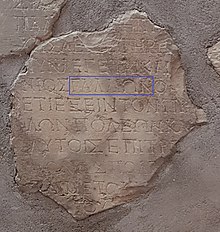Acts 18
This part of the second missionary journey of Paul took place in c. AD 50–52, based on the time when Gallio was proconsul of Achaia.
J. R. Lumby notes that "it is not likely that this was the man's Jewish name, but as the custom was among the Jews, he had probably assumed a Roman name during his dwelling in Italy and in his intercourse with the Gentiles.
[10] Alexander suggests that Luke "may have simplified" the account of Paul's mission in Corinth, as it follows a familiar sequence (verses 4–5).
[12] Other Greek texts read συνειχετο τω λογω (syneicheto tō logō, "constrained by the word").
[15] Following a relatively quiet period of church growth, opposition flares up again and Paul is brought before the proconsul Gallio.
[20] The reference to proconsul Gallio in the Delphi Inscription, or Gallio Inscription (IG, VII, 1676; SIG, II, 801d; AD 52)[21][a][b] provides an important marker for developing a chronology of the life of Apostle Paul by relating it to the trial of Paul in Achaea mentioned in this passage.
[29] In an interlude, Luke gives a rare glimpse of Apollos, an Alexandrian Jew, an independent missionary at work within the almost-exclusive Pauline sphere.
[10] Apollos is a member of one of the largest Jewish communities in the ancient world, with a complex and well-established tradition of philosophical hermeneutics of which Philo is the best-known proponent (cf.
[10] Apollos received a sufficiently Christian instruction (katechesis) to speak about 'the way of the Lord' (verse 25), but it stops short at the 'baptism of John' (Acts 19:3).

